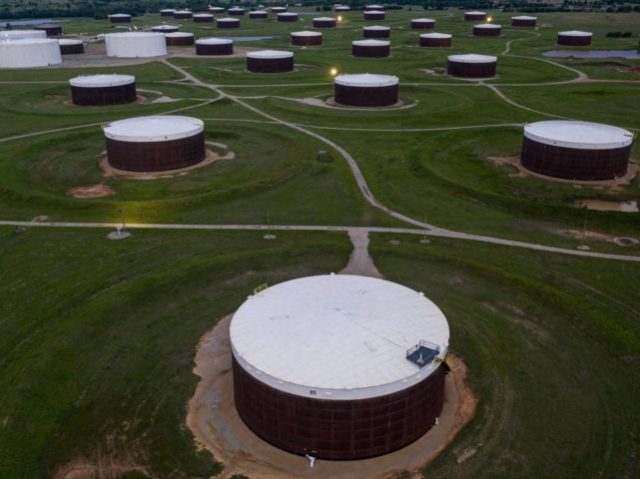U.S. crude-oil stockpiles plunged last week as a pick-up in refining was not matched by a pickup in extraction, which remains paralyzed due to pressure on banks and investors to cut off access to credit and capital for fossil fuel companies.
Crude-oil inventories fell by 3.4 million barrels to 410 million barrels, according to data released Wednesday by the Energy Information Administration. That was a bigger drop than the 2.5 million decline forecast by analysts surveyed by Econoday.
West Texas Intermediate crude futures were up a sharp 3.47 percent following the news to $107.91. Brent crude, the global benchmark, was up 3.36 percent to $113.93.
The American left has campaigned for years to reduce the supply of oil, gas, and coal, especially by reducing domestic production through tightening financial conditions, raising the price of leases or curtailing leasing on federal lands, tax increases on fossil fuel companies, and thwarting the Keystone Pipeline. These are referred to as “restrictive supply side” policies.
On Wednesday, a coalition of climate change alarmist groups issued a report castigating ongoing financial support for fossil fuel companies. “Any bank supporting any company that is expanding fossil fuels is driving climate chaos,” the report claimed.

NEW YORK, NY – OCTOBER 14: Environmental activists protest outside Chase Bank, calling for banks to divest in fossil fuels and invest in renewable energy on October 14, 2015 in New York City. While the protest was billed as an environmental demonstration, activists also protested against racial discrimination, housing issues, controversial techniques used in the financial industry and the prison industrial complex. (Photo by Andrew Burton/Getty Images)
The report shows that the campaign against financing has likely been effective at reducing credit available to fossil fuels. Financing from the four biggest U.S. banks—Bank of America, Citigroup, Wells Fargo, and J.P. Morgan Chase—has fallen from $210 billion in 2019 to $179 billion in 2021, a 14.8 percent drop. Depressed global demand for oil for much of last year, due to economies still staggering under the weight of the pandemic, was also a likely contributor to the decline in financing.
“In 2022, every bank must make ending fossil expansion an explicit precondition for any financial support, while also beginning to zero out financing for the sector altogether,” the climate change alarmist report demands.

Climate activists take part in a demonstration as part of the Global Climate Strike, to call for action against climate change in New York on March 25, 2022. (Photo by Kena Betancur / AFP) (Photo by KENA BETANCUR/AFP via Getty Images)
Oil stockpiles at Cushing, Oklahoma fell by 1 million barrels from the previous week, to 24.2 million barrels, according to the EIA. Cushing is the delivery location for the NYMEX benchmark Light Sweet Crude Oil futures contract. A network of nearly two dozen pipelines and 15 storage terminals, Cushing has 90 million barrels of storage capacity, accounting for 13 percent of total U.S. oil storage.

A pipeline sign reads “Cushing Okla – Pipeline Crossroad of the World” on May 4, 2020 in Cushing, Oklahoma. – (Photo by Johannes EISELE / AFP) (Photo by JOHANNES EISELE/AFP via Getty Images)
U.S. crude-oil production rose by 100,000 barrels a day from the previous week to 11.7 million barrels a day, according to the EIA.
Gasoline inventory was up sharply, unexpectedly climbing by 785,000 barrels to 238.8 million barrels. Analysts had predicted a drop in gasoline inventories.
Distillate inventory, which includes heating oil and diesel fuel, also unexpectedly rose. These grew by 1.4 million barrels to 113.5 million barrels. Despite the build, these are now 16 percent below the five-year average.
Capacity utilization at U.S. refineries jumped by 1 percentage point from the previous week to 92.1 percent. Analysts had forecast a small drop in utilization.

COMMENTS
Please let us know if you're having issues with commenting.